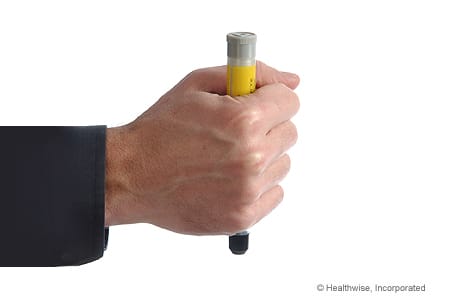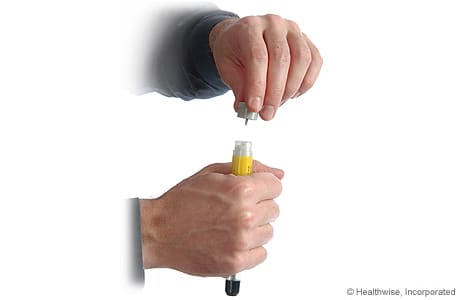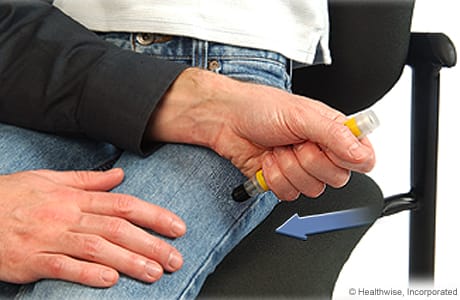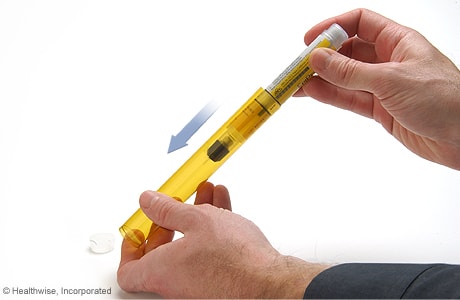Epinephrine
Epinephrine is an injected medicine used to treat severe allergic reactions, breathing problems, and cardiac arrest.
Epinephrine:
- Narrows the blood vessels, which raises blood pressure. This may prevent the severe low blood pressure that occurs during a severe allergic reaction.
- Stops leakage of fluids from blood vessels into body tissues.
- Relaxes the muscles of the respiratory tract, relieving wheezing and breathing difficulty.
- Increases the heart rate.
A severe or fatal stroke, heart irregularity, or heart attack can occur if the wrong dose of epinephrine is mistakenly injected into a blood vessel or if an overdose is given.
How to give an epinephrine shot to a child

1. Grasp the epinephrine shot injector in one fist with the tip pointing down. Be sure you know which end of the injector is the tip and which end is the top. Do not touch the tip.

2. With your other hand, pull off the cap.

3. Give the injection.
- Hold your child's leg firmly with one hand, and hold the injector tip close to your child's thigh.
- Jab the tip firmly into your child's thigh. Jab through clothing if you must, but bare skin is best. The injector tip should go straight into the skin, at a 90-degree angle to the thigh.
- Keep the injector tip in your child's thigh for 10 seconds. The injection is then complete. It is normal for most of the liquid to be left in the injector. Do not try to inject the remaining fluid.
- Remove the injector, and place your hand on the area where the medicine entered the skin. Rub the area for about 10 seconds.

4. Put the used injector—needle-first—back into its storage tube. Do not bend the needle. Screw on the cap of the storage tube.
Take your child to the emergency room, and bring the used injector with you.
How to Give Yourself an Epinephrine Shot
Why should you keep your child's epinephrine nearby at all times?
If your child has had a severe allergic reaction (anaphylaxis) in the past, you know how frightening it can be. Symptoms of breathing problems, itching, belly pain, nausea or vomiting, diarrhea, and swelling can come on quickly and become life-threatening. Giving your child an epinephrine shot can slow down or stop an allergic reaction. That's why it is important to have epinephrine with you at all times and to know the right way to use it. It could save your child's life someday.
What should you do after giving your child an epinephrine shot?
Your child should feel the effects of the epinephrine shot almost right away. These may include a rapid heartbeat and nervousness as well as improved breathing. The benefits of the shot usually last 10 to 20 minutes.
Symptoms can come back after the shot. So get your child to the emergency room right away, even if your child is feeling better.
In some severe cases, you may need to give a second shot. Your doctor will explain when a second shot is needed. Make sure you understand, and ask questions if you are not sure. Too much epinephrine can cause serious side effects, such as difficulty breathing.
After giving the shot
- Immediately call 911. Tell the operator that you gave your child a shot for a severe allergic reaction. Or if a hospital is close by, take your child to the emergency room. At the hospital, give the doctor or nurse the used injector. It will be checked and then disposed of properly.
- Your child may need to be observed in the hospital for several hours to make sure symptoms don't return.
- If your child has any heart problems, be sure to tell the doctor or nurse.
©2011-2025 Healthwise, Incorporated
